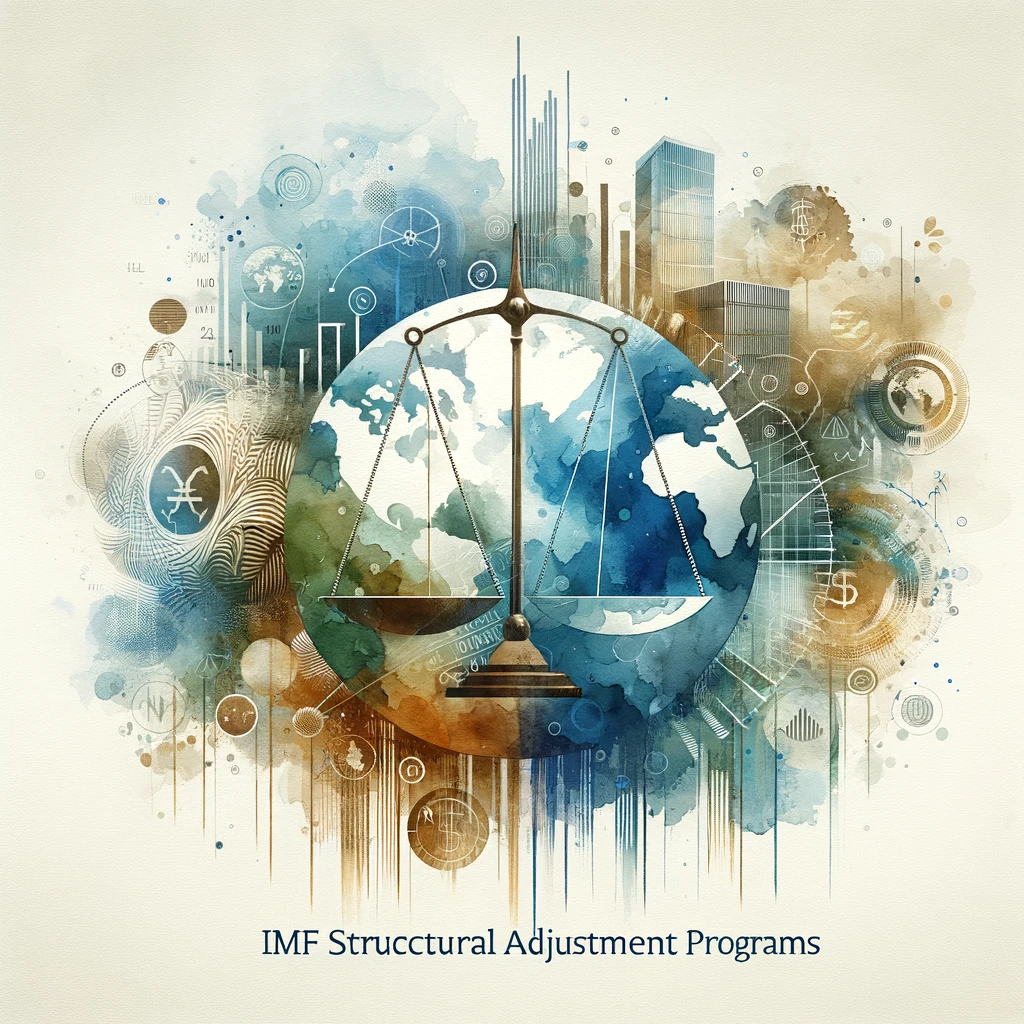International economic organizations play a vital role in maintaining global economic stability, fostering economic growth, and providing support to countries in times of financial distress. One of the most influential of these organizations is the International Monetary Fund (IMF). This article explores the role of the IMF, its functions, and its impact on the global economy.

1. Role of the International Monetary Fund (IMF)
Purpose and Functions of the IMF
Providing Financial Assistance and Stability
The IMF was established in 1944 with the goal of promoting international monetary cooperation and providing financial stability. It provides financial assistance to member countries facing balance of payments problems, helping them stabilize their economies and restore confidence. The IMF’s lending facilities offer short-term financial support to address urgent financial needs and long-term loans for structural reforms.
Example: In 2020, during the COVID-19 pandemic, the IMF provided emergency financial assistance to over 80 countries to help them manage the economic fallout and stabilize their economies.
Monitoring Global Economic Trends and Policies
The IMF conducts regular surveillance of the global economy, monitoring economic trends, and assessing the economic policies of its member countries. Through its World Economic Outlook reports and country-specific assessments, the IMF provides valuable insights and recommendations for economic policy and management.
Example: The IMF’s annual Article IV consultations involve a thorough review of a country’s economic policies and performance, providing policy advice and recommendations to support economic stability and growth.

Technical Assistance and Capacity Building
The IMF offers technical assistance and training to member countries to help them strengthen their economic institutions and policy frameworks. This includes support in areas such as public finance management, monetary policy, exchange rate systems, and financial regulation.
Example: The IMF provides training programs for government officials and technical experts to enhance their capacity in economic management and policy implementation, contributing to more effective economic governance.
IMF Structural Adjustment Programs
Objectives and Conditions of IMF Loans
IMF loans often come with conditions known as structural adjustment programs (SAPs). These programs are designed to address underlying economic problems and promote sustainable growth. The conditions typically include policy reforms aimed at reducing fiscal deficits, controlling inflation, liberalizing trade, and improving governance.
Example: In the 1980s and 1990s, many developing countries received IMF loans that required them to implement structural adjustment policies, such as reducing public spending and privatizing state-owned enterprises, to stabilize their economies and promote growth.
Impact on Borrowing Countries’ Economies
While structural adjustment programs have helped some countries stabilize their economies and achieve economic growth, they have also been criticized for their social and economic impacts. Critics argue that the focus on austerity measures and market liberalization can lead to higher unemployment, reduced social spending, and increased inequality.
Example: In countries like Argentina and Greece, IMF programs have been associated with significant economic adjustments, but also with social hardship and political unrest, as governments implemented tough economic reforms.
Controversies and Criticisms of Adjustment Policies
IMF structural adjustment programs have been controversial due to their perceived negative impacts on vulnerable populations and their focus on market-oriented reforms. Critics argue that the IMF’s approach can lead to a loss of sovereignty for borrowing countries, as they are required to implement policies that may not align with their domestic priorities or social needs.
Example: In the 1990s, IMF programs in Sub-Saharan Africa were criticized for prioritizing fiscal austerity and trade liberalization at the expense of social services and poverty reduction, leading to widespread criticism from civil society organizations.

Reforms and Criticisms of the IMF
Calls for Governance Reforms and Transparency
There have been numerous calls for reforms to the IMF’s governance structure to make it more representative and transparent. Critics argue that the current system gives disproportionate influence to advanced economies, particularly the United States and European countries, while underrepresenting developing countries and emerging markets.
Example: Efforts to reform the IMF’s quota system, which determines voting power and financial contributions, aim to increase the representation of emerging economies like China and India, reflecting their growing importance in the global economy.
Addressing Inequalities and Debt Relief
The IMF has been criticized for not doing enough to address global inequalities and provide debt relief to heavily indebted poor countries. In response, the IMF has launched initiatives like the Heavily Indebted Poor Countries (HIPC) Initiative and the Multilateral Debt Relief Initiative (MDRI) to provide debt relief and support poverty reduction efforts.
Example: Under the HIPC Initiative, countries like Uganda and Bolivia have received significant debt relief, enabling them to allocate more resources to social programs and economic development.
Role in Global Financial Crises and Recovery
The IMF has played a critical role in managing and responding to global financial crises, providing financial assistance and policy advice to countries in distress. However, its role has been criticized for being reactive rather than proactive, with calls for the IMF to do more to prevent crises and support sustainable development.
Example: During the 2008 global financial crisis, the IMF provided emergency loans and support to countries like Iceland, Hungary, and Pakistan, helping them stabilize their economies and recover from the crisis.
IMF’s Role in Global Economic Governance
Coordination with Other International Organizations
The IMF collaborates with other international organizations, such as the World Bank, the World Trade Organization (WTO), and the United Nations, to promote global economic stability and development. This coordination helps ensure that economic policies and development efforts are aligned and mutually reinforcing.
Example: The IMF and the World Bank work together on initiatives like the Financial Sector Assessment Program (FSAP), which evaluates the stability of financial systems and provides recommendations for strengthening financial regulation and supervision.
Influence on Global Economic Policies
The IMF plays a significant role in shaping global economic policies through its policy advice, research, and surveillance activities. Its recommendations on fiscal policy, monetary policy, and structural reforms influence the economic policies of member countries and the broader global economic agenda.
Example: The IMF’s advocacy for fiscal discipline and sound economic management has influenced the economic policies of countries around the world, promoting stability and growth in both advanced and developing economies.
Future Challenges and Areas for Reform
The IMF faces several challenges in the coming years, including the need to address the impacts of climate change, support sustainable development, and manage the risks associated with global financial integration. There are calls for the IMF to strengthen its focus on social and environmental issues and to enhance its role in promoting inclusive and sustainable economic growth.
Example: The IMF’s recent focus on integrating climate risks into economic policy assessments and supporting green finance initiatives reflects its commitment to addressing the challenges of climate change and promoting sustainable development.
Case Studies of IMF Interventions
Financial Crises in Latin America and Asia
The IMF has been involved in several major financial crises in Latin America and Asia, providing financial assistance and policy advice to stabilize economies and promote recovery.
Example: During the Latin American debt crisis of the 1980s, the IMF provided loans and support to countries like Mexico and Brazil, helping them manage their debt burdens and implement economic reforms. In the Asian financial crisis of 1997-1998, the IMF supported countries like Thailand, Indonesia, and South Korea with emergency loans and policy recommendations to restore economic stability.
Greece and the European Debt Crisis
The IMF played a crucial role in the European debt crisis, particularly in Greece, where it provided financial assistance and policy advice to help the country manage its debt crisis and implement economic reforms.
Example: The IMF, along with the European Central Bank and the European Commission, formed the “Troika” that provided financial support to Greece under a series of bailout programs. These programs aimed to stabilize Greece’s economy, reduce its debt levels, and implement structural reforms to promote growth and competitiveness.
IMF’s Role in Post-Crisis Recovery
The IMF has been instrumental in supporting countries’ recovery from financial crises, providing financial assistance and policy guidance to help them rebuild their economies and achieve sustainable growth.
Example: In the aftermath of the 2008 global financial crisis, the IMF provided support to countries like Ireland and Portugal, helping them stabilize their economies and implement reforms to promote recovery and long-term growth.
Data Reference Points:
- IMF Membership: The IMF has 190 member countries, representing a wide range of economies and regions.
- IMF Loans: The IMF provides financial assistance through various lending facilities, including the Stand-By Arrangement (SBA) and the Extended Fund Facility (EFF).
- Debt Relief Initiatives: The HIPC Initiative has provided debt relief to 37 countries, contributing to poverty reduction and economic development.

